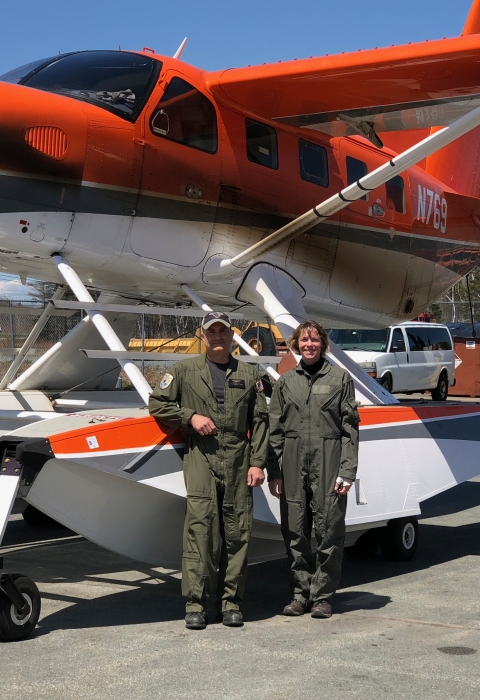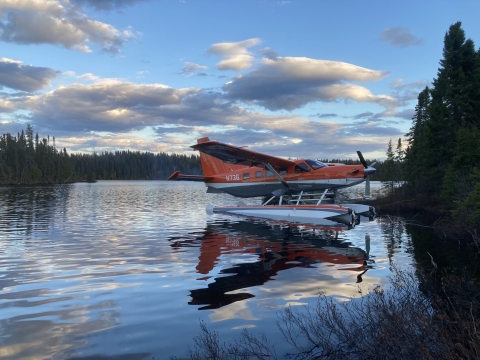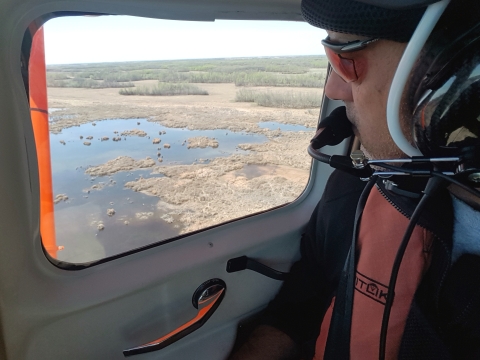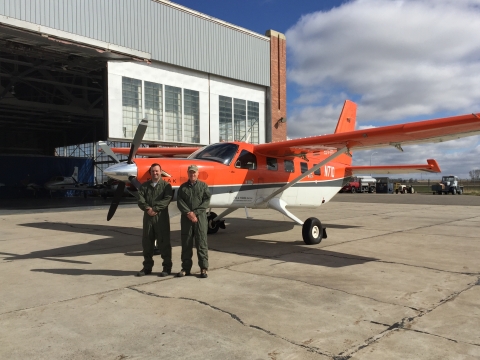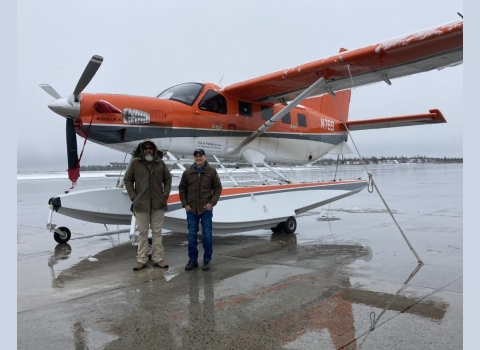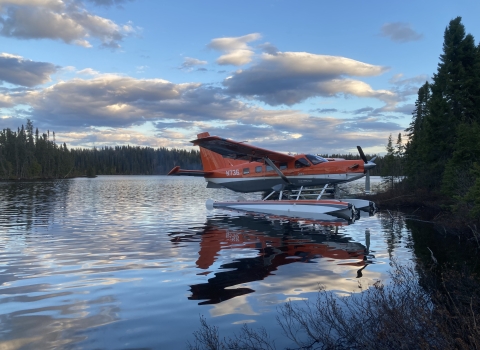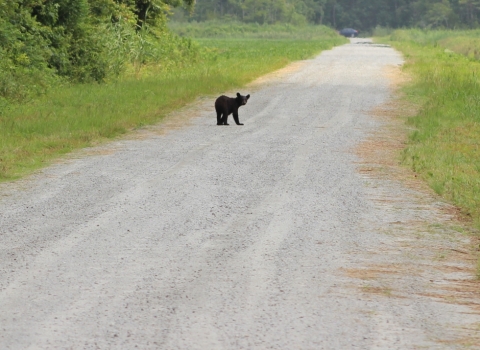Who We Are
The U.S. Fish and Wildlife Service’s Pilot Biologists are some of the most unique and specially trained employees in the agency. Considered “dual function” positions, pilot biologists are qualified not only as wildlife biologists, but also as aircraft pilots, operating specialized survey aircraft in support of natural resources management objectives.
What We Do
Pilot biologists design, plan, coordinate, and implement continental population and habitat monitoring programs that inform wildlife management and conservation actions in the U.S., Canada, and Mexico. Specifically, we conduct low-level surveys and high-altitude remote-sensing missions to monitor the status of waterfowl and other migratory birds, large mammals, and other wildlife. We also conduct radio-tracking surveys, law enforcement and fire reconnaissance flights, field station support missions, wildlife relocation flights, and respond to environmental disasters, including hurricanes and oil spills. We coordinate with other agencies and are known as the eyes-in-the-sky for the U.S. Fish and Wildlife Service, monitoring wildlife populations and natural resources across the breadth of the North American continent.
How Do I Become a U.S. Fish and Wildlife Service Pilot Biologist?
Pilot biologists must meet federal qualification standards for both education as a general biologist or wildlife biologist, and the minimum aviation qualifications to qualify for a dual function pilot biologist position.
College Education Requirement: Depending on specific position requirements, you must meet the minimum requirements for a General Biologist Position (401 series) or a Wildlife Biologist (486 series). In general, these positions require, at a minimum, a full four-year course of study at an accredited college or university leading to a bachelor’s degree in biological sciences, wildlife biology or management, agriculture, natural resource management, or a discipline related to this position. Some series, such as GS-486 have more specialized minimum educational requirements.
If you have not completed the requirement for a relevant four-year degree, you may still qualify if you have a combination of both education and experience that includes course work equivalent to a major in biological sciences or related discipline, and appropriate experience or additional course work. The combination of education and experience must demonstrate that you possess the knowledge, skills, and abilities required to perform the work of the position and is comparable to that normally acquired through the completion of a full four-year course of relevant study. Note that some pilot biologist positions may require more advanced education or experience to minimally qualify.
Pilot Qualification Requirement: The successful applicant must:
1. possess a current FAA Commercial Airman Certificate with rating appropriate for the duties performed;
2. possess an instrument rating, and 10 hours as Pilot-in-Command in actual or simulated instrument flight rules (IFR) conditions;
3. have completed a minimum of 500 hours of flight time as Pilot-in-Command;
4. have completed 25 hours as Pilot-in-Command at night; and
5. possess a current Class II Medical Certificate.
Other Requirements and Conditions:
- Must be a U.S. Citizen or National
- Males born after 12-31-59 must be registered for Selective Service
- Must successfully pass a background investigation and drug testing
- Must meet medical requirements
- You may be required to carry a firearm in the performance of your duties
- Official U.S. Fish and Wildlife Service uniform may be required
- May be required to successfully complete a probationary period
What Knowledge and Skills Do I Need?
Specific knowledge required for the position will be related to the position’s geographic location, programmatic affiliation, and job responsibilities. For example, a position in the Migratory Bird Program will require special knowledge about waterfowl and other migratory birds whereas a position in the National Wildlife Refuge System may require special knowledge about large mammals or other natural resources. General knowledge, skills, and abilities required include the following:
- Knowledge of the principles, practices, techniques, and concepts of population ecology and wildlife biology, as related to the management and conservation of wildlife
- Knowledge of federal migratory bird, endangered species, and National Wildlife Refuge laws, regulations, and other related government, departmental, and agency policies, programs, goals and objectives
- Ability to analyze biological survey data, interpret results and prepare completed reports
- Ability to pilot a fixed-wing amphibious survey aircraft in accordance with regulations and standards, and to conduct low-level aerial surveys of wildlife.
- Ability to operate light, single-engine or multi-engine, fixed-wing aircraft from land or water, including flight planning and associated logistics, while maintaining FAA compliant records and documentation.
What Types of Pilot Biologists Jobs Are There and what is the Job like?
The U.S. Fish and Wildlife Service has several programs that employ pilot biologists to conduct critical wildlife conservation programs including the Migratory Bird Program, National Wildlife Refuge System, and Office of Law Enforcement.
Pilot biologists in the Migratory Bird Program are stationed throughout the United States. They are responsible for monitoring waterfowl and other migratory bird populations for the purposes of establishing harvest regulations, conducting status assessments, and conserving and managing habitats. Surveys are often conducted at low altitude but may also involve high altitude operations using advanced remote sensing and machine learning technologies. Migratory bird pilot biologists travel the breadth of the North American continent monitoring populations and habitats during critical breeding, migration, and wintering periods. Field operations can be for extended periods of time in relation to biological events and cycles. Migratory bird pilot biologists are fortunate to experience vast and remote landscapes across the continent in a way very few people do. Migratory bird pilot biologists, given their wide geographic distribution and long-range survey aircraft, are often called upon to assist other programs and agencies and to respond to environmental disasters. The nature of these positions require pilot biologists to operate independently with limited support to safely conduct challenging aviation missions while collecting the quality data necessary to support management and conservation decisions.
Pilot biologists in the National Wildlife Refuge System share many duties with migratory bird pilot biologists but their priorities and responsibilities are directed by those of the Refuge or Wetland Management District to which the dual function position is assigned. Refuge System pilot biologists tend to have more of a Regional of Refuge-focused area of operation, but like migratory bird dual function positions often get called to assist other programs or agencies in other areas. Most dual function pilot biologist positions in the Refuge System are located in Alaska.
A number of dual function positions also exist within in the Office of Law Enforcement. These positions are law enforcement agent-pilot positions. These positions focus on specialized wildlife and natural resources law enforcement activities, providing critical aerial reconnaissance and support. All dual function agent pilot positions are presently located in Alaska, while the migratory bird biologist pilots provide law enforcement support in the contiguous U.S. The educational and experience requirements may differ from those of other types of pilot biologists.
New pilot biologists or agent biologists typically go through a period of 1-3 years of intensive training prior to assuming full performance duties, with the training period dependent upon prior experience and qualifications.
How much do Pilot Biologists earn?
This depends on the General Schedule (GS) grade of the specific position, your experience level at hiring, and location of the duty station. Most pilot biologists are hired at the GS-11/12/13 with salary ranging from $60,000-$120,000. A few dual function positions within the Service are supervisory at the GS-14 level.
How Do I Find a Job?
USAJOBS.gov is where all U.S. Fish and Wildlife Service Job Opportunities are Announced. You can have notifications sent to your email when certain jobs open up.
